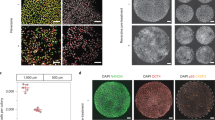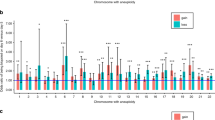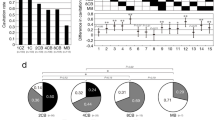Abstract
A READY supply of parthenogenetic mammalian embryos would be useful. Parthenogenones which develop from unfertilized eggs may be haploid, diploid or polyploid, depending on whether the meiotic divisions and first cleavage division occur1. Haploid cells can be used for studying cellular genetics and embryology. Diploid cells, if they arise by suppression of the polar bodies, can be used to map genes in relation to the centromere2.
This is a preview of subscription content, access via your institution
Access options
Subscribe to this journal
Receive 51 print issues and online access
$199.00 per year
only $3.90 per issue
Buy this article
- Purchase on Springer Link
- Instant access to full article PDF
Prices may be subject to local taxes which are calculated during checkout
Similar content being viewed by others
References
Beatty, R. A., Parthenogenesis and Polyploidy in Mammalian Development (Cambridge University Press, 1957); Austin, C. R., The Mammalian Egg (Blackwell's Scientific Publications, Oxford, 1961).
Haldane, J. B. S., in Animal Cytology and Evolution (by White, M. J. D.), 283 (Cambridge University Press, 1945).
Graham, C. F., Symp. Wistar Inst., No. 9, 19 (1969).
Runner, M. N., and Palm, J., J. Exp. Zool., 124, 303 (1953).
Whitten, W. K., and Biggers, J. D., J. Reprod. Fert., 17, 399 (1968).
Mulnard, J. G., Arch. Biol., Liège, 78, 107 (1967).
Whitten, W. K., Biol. Reprod., 1, 29 (1969).
Tarkowski, A. K., Cytogenetics, 5, 394 (1966).
Dasgupta, S., J. Exp. Zool., 151, 105 (1962).
Tarkowski, A. K., Nature, 190, 857 (1961).
Mintz, B., Science, 138, 594 (1962).
McLaren, A., and Michie, D., J. Exp. Biol., 33, 394 (1956).
Vogt, M., and Dulbecco, R., Proc. US Nat. Acad. Sci., 49, 171 (1963).
Kirby, D. R. S., J. Embryol. Exp. Morphol., 10, 496 (1962).
Schlesinger, M., and Koren, Z., Fert. Steril., 18, 95 (1967).
Sanford, K. K., Covalevsky, A. B., Dupree, L. T., and Earle, W. R., Exp. Cell Res., 23, 361 (1961).
Watkins, J. F., and Chen, L., Nature, 223, 1018 (1969).
Freed, J. J., Exp. Cell Res., 26, 327 (1962).
Freed, J. J., and Freed, L. M., Proc. US Nat. Acad. Sci., 65, 337 (1970).
Richards, B. M., Walker, P. M. B., and Deeley, E. M., Ann. NY Acad. Sci., 63, 831 (1956).
Author information
Authors and Affiliations
Rights and permissions
About this article
Cite this article
GRAHAM, C. Parthenogenetic Mouse Blastocysts. Nature 226, 165–167 (1970). https://doi.org/10.1038/226165a0
Received:
Issue Date:
DOI: https://doi.org/10.1038/226165a0
This article is cited by
-
Temporal regulation of prenatal embryonic development by paternal imprinted loci
Science China Life Sciences (2020)
-
Derivation and maintenance of mouse haploid embryonic stem cells
Nature Protocols (2019)
-
Haploid genomes illustrate epigenetic constraints and gene dosage effects in mammals
Epigenetics & Chromatin (2013)
-
Parthenogenesis of human oocytes as a function of vacuum pressure
Journal of In Vitro Fertilization and Embryo Transfer (1989)
-
Normal postimplantation development of mouse parthenogenetic embryos to the forelimb bud stage
Nature (1977)
Comments
By submitting a comment you agree to abide by our Terms and Community Guidelines. If you find something abusive or that does not comply with our terms or guidelines please flag it as inappropriate.



